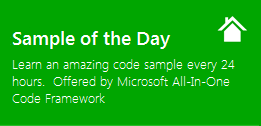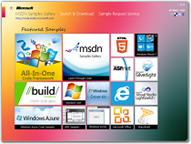[Sample of May 14th] Image slideshow in full screen mode
 |  | |
 |  | |
Sample Downloads: https://code.msdn.microsoft.com/CSImageFullScreenSlideShow-79e29568
Today’s sample demonstrates how to display image slideshow in a Windows Forms application. It also shows how to enter the full screen mode to slide-show images. The sample was written by our sample writer: Jason Wang.
 You can find more code samples that demonstrate the most typical programming scenarios by using Microsoft All-In-One Code Framework Sample Browser or Sample Browser Visual Studio extension. They give you the flexibility to search samples, download samples on demand, manage the downloaded samples in a centralized place, and automatically be notified about sample updates. If it is the first time that you hear about Microsoft All-In-One Code Framework, please watch the introduction video on Microsoft Showcase, or read the introduction on our homepage https://1code.codeplex.com/.
You can find more code samples that demonstrate the most typical programming scenarios by using Microsoft All-In-One Code Framework Sample Browser or Sample Browser Visual Studio extension. They give you the flexibility to search samples, download samples on demand, manage the downloaded samples in a centralized place, and automatically be notified about sample updates. If it is the first time that you hear about Microsoft All-In-One Code Framework, please watch the introduction video on Microsoft Showcase, or read the introduction on our homepage https://1code.codeplex.com/.
Introduction
The sample demonstrates how to display image slideshow in a Windows Forms application. It also shows how to enter the full screen mode to slide-show images.
Running the Sample
Step1. Build and run the sample project in Visual Studio 2010.
Step2. Prepare some image files. Click the "Open Folder..." button and select the path which includes image files.
Step3. Click "Previous" button and "Next" button to make image files displayed in order.
Step4. Left-click the "Settings" button and select the internal between the displayed image files for Timer control in order to display them with a fixed interval time. Finally, left-click the "Start Slideshow" button to make the image files displayed one by one.
Step5. Left-click the "Full Screen" button to display images in the full screen mode. Press the "ESC" key to leave the full screen mode.
Using the Code
1. When user selects the root folder of image files, the sample enumerates the image files in the folder using the stack-based iteration method demonstrated in this MSDN article: https://msdn.microsoft.com/en-us/library/bb513869.aspx
The sample does not use Directory.GetFiles(path, "*.*", SearchOption.AllDirectories); to enumerate the files because it will abort when the user does not have access permissions for certain directories or files in the root folder.
public static string[] GetFiles(string path, string searchPattern)
{
string[] patterns = searchPattern.Split(';');
List<string> files = new List<string>();
foreach (string filter in patterns)
{
// Iterate through the directory tree and ignore the
// DirectoryNotFoundException or UnauthorizedAccessException
// exceptions.
// https://msdn.microsoft.com/en-us/library/bb513869.aspx'>https://msdn.microsoft.com/en-us/library/bb513869.aspx'>https://msdn.microsoft.com/en-us/library/bb513869.aspx'>https://msdn.microsoft.com/en-us/library/bb513869.aspx
// Data structure to hold names of subfolders to be
// examined for files.
Stack<string> dirs = new Stack<string>(20);
if (!Directory.Exists(path))
{
throw new ArgumentException();
}
dirs.Push(path);
while (dirs.Count > 0)
{
string currentDir = dirs.Pop();
string[] subDirs;
try
{
subDirs = Directory.GetDirectories(currentDir);
}
// An UnauthorizedAccessException exception will be thrown
// if we do not have discovery permission on a folder or
// file. It may or may not be acceptable to ignore the
// exception and continue enumerating the remaining files
// and folders. It is also possible (but unlikely) that a
// DirectoryNotFound exception will be raised. This will
// happen if currentDir has been deleted by another
// application or thread after our call to Directory.Exists.
// The choice of which exceptions to catch depends entirely
// on the specific task you are intending to perform and
// also on how much you know with certainty about the
// systems on which this code will run.
catch (UnauthorizedAccessException)
{
continue;
}
catch (DirectoryNotFoundException)
{
continue;
}
try
{
files.AddRange(Directory.GetFiles(currentDir, filter));
}
catch (UnauthorizedAccessException)
{
continue;
}
catch (DirectoryNotFoundException)
{
continue;
}
// Push the subdirectories onto the stack for traversal.
// This could also be done before handing the files.
foreach (string str in subDirs)
{
dirs.Push(str);
}
}
}
return files.ToArray();
}
2. The sample displays the images in a PictureBox.
/// <summary>
/// Show the image in the PictureBox.
/// </summary>
public static void ShowImage(string path, PictureBox pct)
{
pct.ImageLocation = path;
}
/// <summary>
/// Show the previous image.
/// </summary>
private void ShowPrevImage()
{
ShowImage(this.imageFiles[(--this.selected) % this.imageFiles.Length], this.pictureBox);
}
/// <summary>
/// Show the next image.
/// </summary>
private void ShowNextImage()
{
ShowImage(this.imageFiles[(++this.selected) % this.imageFiles.Length], this.pictureBox);
}
A timer is used to automatically slideshow the images.
/// <summary>
/// Show the next image at every regular intervals.
/// </summary>
private void timer_Tick(object sender, EventArgs e)
{
ShowNextImage();
}
2. To slide-show images in the full-screen mode, the sample provides a helper class 'FullScreen'. FullScreen.cs contains two public methods:
EnterFullScreen - used to make a Windows Form display in the full screen.
LeaveFullScreen - used to restore a Windows Form to its original state.
/// <summary>
/// Maximize the window to the full screen.
/// </summary>
public void EnterFullScreen(Form targetForm)
{
if (!IsFullScreen)
{
Save(targetForm); // Save the original form state.
targetForm.WindowState = FormWindowState.Maximized;
targetForm.FormBorderStyle = FormBorderStyle.None;
targetForm.TopMost = true;
targetForm.Bounds = Screen.GetBounds(targetForm);
IsFullScreen = true;
}
}
/// <summary>
/// Leave the full screen mode and restore the original window state.
/// </summary>
public void LeaveFullScreen(Form targetForm)
{
if (IsFullScreen)
{
// Restore the original Window state.
targetForm.WindowState = winState;
targetForm.FormBorderStyle = brdStyle;
targetForm.TopMost = topMost;
targetForm.Bounds = bounds;
IsFullScreen = false;
}
}
More Information
How to: Iterate Through a Directory Tree (C# Programming Guide)
https://msdn.microsoft.com/en-us/library/bb513869.aspx
Screen.GetBounds Method
https://msdn.microsoft.com/en-us/library/system.windows.forms.screen.getbounds.aspx